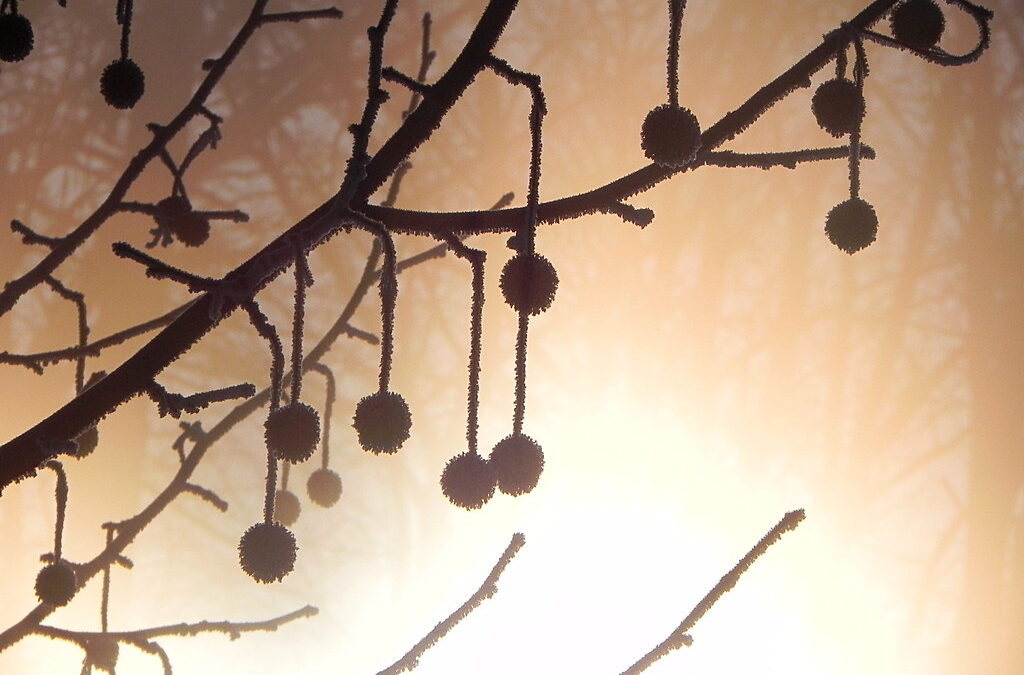By Sarah Hatfield
When I think about winter, there are a number of images that come to mind. After I get done internally grumbling (for I hate being cold), I settle into a type of mental torpor and sense of peace and serenity. Silent, snow-covered landscapes, intricate snow crystals, frosted window panes, and steaming mugs of hot chocolate are fairly ubiquitous symbols of the season. Others are tailored more toward certain lifestyles – heavy, handmade quilts, fresh pies from summer-harvested berries, and the faint but relentless aroma of wood smoke. Still others are unique to individuals or childhoods, such as moving the comfy chair over the warmest heat vent.
Yet there are some symbols that seem to transcend cultures and countries, and while slightly different, represent similar beliefs and feelings. Rebirth, renewal, hope, balance, rest, recovery, gratitude. These feelings and beliefs are why we fill our homes with light, evergreens, berries, sparkles, gifts, and trinkets and treasures that hold our memories.
What better symbol of hope and renewal than evergreens? They maintain their namesake color throughout the year, helping us believe that we, too, can survive the cold and dark, and reach the growing season with energy and vigor. Evergreens often have tougher leaves, perhaps thicker, more waxy, or overlapping. While many people would think these ‘leaves’ strange indeed, their oddity is their strength. Evergreens approach life and the challenges it brings with an alternative strategy and do just fine. One could argue that their uniqueness of approach is what has made them such a strong symbol of hope. Perhaps all that we label odd and different is similar? Simply another way of approaching life, but one that is just as effective, and possibly inspiring for others.

Naturally, as the darkest portion of the year approaches, light is considered hopeful, encouraging, warming, comforting. In modern times we manifest this with light-emitting diodes strung together to outline our homes, plastic reindeer, shrubs, trees, and snowmen. The most celebratory (I imagine) form of light is that of the sun, the source of all living things on the planet and around which ancient and modern cultures organize their literal lives. The planting and growing of food, the biological triggers that stimulate growth and reproductive cues among the plants and animals, all revolve around the presence of sunlight and day length.
Sensible it is, then, that humans adopted this as a symbol of hope and brought it into our ceremonies and homes in the form of fire. Bonfires, candles, and lanterns have long been part of winter festivities, many celebrating the days beginning to lengthen after the solstice – a definitive hopeful sign for so many. With the discovery and harnessing of electricity, bringing light into our winter holidays is safer and easier, and certainly does make thing more cheerful, enchanting, and soothing.
Berries, nuts, and cones are common among winter symbols. From a natural perspective, these are the epitome of hope – inside each lies the potential for new life, waiting for the right time and place to burst forth into the world. No wonder they are present as a winter decoration and symbol.
Additionally, they represent the bounty that the natural world produces, and of which humans take full advantage with gratitude. The protein and fat in many nuts was essential for surviving the lean winter months, especially for those without a meat source. Wild animals and humans alike would hoard the autumn harvests for winter sustenance. It is the perfect food for a winter feast and a lovely symbol of gratitude and hope.
All of these symbols have other meanings, too, assigned as time passes and cultures adapt and evolve. We have little need these days to gather in community groups, give thanks for the rich harvest, sacrifice a lamb, pig, or cow as an offering, light a fire and dance around it. However, the traditions continue with the symbols, linking us to an older knowledge. We still give food at the holidays, sharing our plentiful harvests with those less fortunate. We still give gifts in gratitude for friendship and love, though to each other more often than gods and spirits. We light the lights and sing, we decorate with evergreens and bring the hope indoors to adorn our homes. With these natural and ages-old traditions and symbols, we move forward with our own: Christmas Eve feasts with friends, the planting of a lemon seed on the solstice, hand-stitching a winter quilt from past years worn-out textiles.
Whatever your symbols of the season are, embrace them. The odd, the traditional, the established, the new: they are all what binds humans together, and in many cases, what binds humans to the natural cycles of the world, if only for a brief part of a single season. Cheers to you as Mother Nature wraps us all in winter.
Sarah Hatfield is Education Coordinator at ACNC.
Audubon Community Nature Center builds and nurtures connections between people and nature. ACNC is located just east of Route 62 between Warren and Jamestown. The trails are l open from dawn to dusk as is Liberty, the Bald Eagle. The Nature Center is open, including restrooms, the Blue Heron Gift Shop, Indoor Nature Play Area and most exhibits. More information can be found online at auduboncnc.org or by calling (716) 569-2345.


Recent Comments